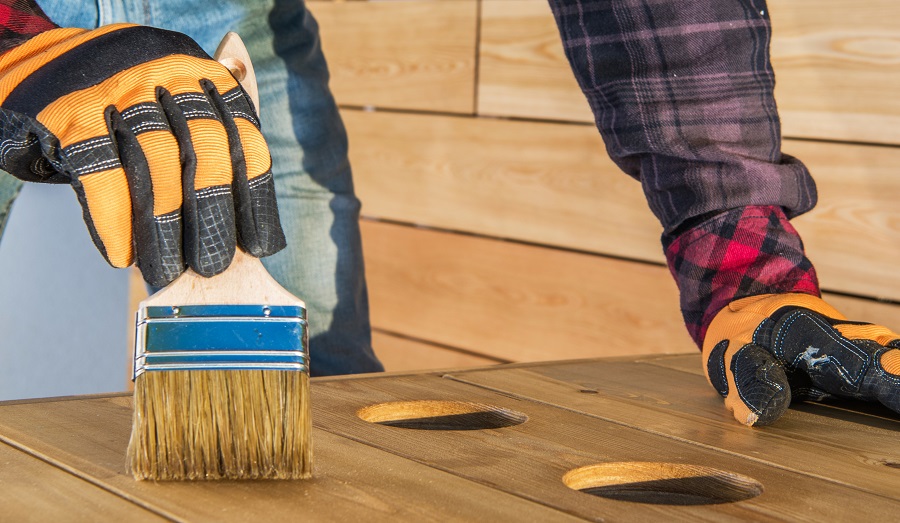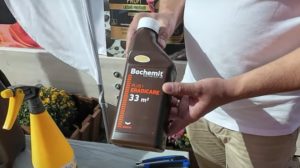Someone asked me if they could apply a water-based exterior resistant varnish over linseed oil treated wood. The varnish was recommended by a friend who had used it and was very pleased with the result. His friend had applied it directly to the wood, but the questioner had heard that it was very good to treat the wood with linseed oil first. My answer was: no. Water-based varnish over linseed oil does not work because water and oil simply do not get on, they repel each other! It doesn't work even if 3-4 days after applying the oil, as I saw a recommendation on a profile group 😐 Even if at the moment everything seems fine and nothing happens, serious problems can occur over time. I'll explain why in a moment.

Water-based varnish does not work over linseed oil even 3-4 days after application
Linseed oil applied is absorbed by the wood inside, it does not remain on the surface. In fact, it doesn't have to, because it doesn't dry in contact with air and doesn't form a film. This is why a surface over-treated with linseed oil and not dried becomes sticky. Usually 2-3 coats of linseed oil are applied, with 24 hours "drying" time between coats. This is actually the time allowed for the wood to absorb as much of the oil as possible into the interior.
Because it does not form a film, after 3-4 days after application, especially in cases where the quantity applied has not been very large and the wood is not saturated, the oily appearance of the surface may disappear. A water-based product applied to this surface will no longer slip very noticeably and will no longer form the characteristic islands. If the sanding has been coarser, the varnish is still absorbed by some of the open wood fibers and this creates the impression that the water-based varnish has gone very well over the linseed oil.
The problem can occur during very hot summer periods. At high temperatures, the oil inside the varnish expands and pushes into the varnish film, which doesn't have a very good grip on the wooden surface anyway. This causes the film to peel off from place to place, just enough to allow water to enter. The varnish begins to peel, and in some places the wood begins to blacken due to mold growth.
A water-based varnish or paint can be applied to an oil-treated surface months after application, when the linseed oil has been washed off by rain and the wood has a dry look. The presence of oil in the wood gives it a slightly damp appearance. Perhaps this is why the oil is said to nourish the wood. When the wood looks dry, lifeless, without the silky sheen of the oil, a water-based product can be applied to the wood.
So which product goes over linseed oil?
Alkyd or oil-based products. That is, varnishes or paints that use white spirit (petrosine, gas, petroleum-derived solvent) or turpentine (thinner extracted from resinous wood) for dilution. They are oil compatible and will not slip on surfaces treated with linseed oil. Be careful, however, they will not adhere well to sticky oily surfaces. Before application the surface should be wiped with white spirit to remove the gum formed by excess oil.
Linseed oil is a good protection against moisture, but works best in combination with tung oil. Danish oil or Kreidezeit oils are such examples of blends of linseed oil and tung oil with very good results in wood protection. Linseed oil has a smaller molecule than other oils and penetrates faster and deeper into the wood. But the fact that it doesn't form a film allows water to remove it more easily, and a molecule that enters easily can just as easily come out when the surface is subjected to the action of running water (rain, shower areas, etc). Plain linseed oil is one of the least resistant solutions for exterior wood, with no UV protection, the protection given only by the addition of pigments.
To guarantee long-lasting resistance over time, use protection systems tested and guaranteed by the manufacturer
If you want to protect exterior wood, choose systems that are tested and guaranteed by the manufacturer. Whether oils, solvent-based products or water-basedIf you choose the same manufacturer's system, choose all the system from the same manufacturer and follow the recommended technology to guarantee long-lasting resistance. Protect the wood also on the parts that are not visible, as water gets into the wood through there and reduces the resistance of the finish. If you are doing an exterior job, finish the components before fitting to make sure you have properly protected the wood. At the installation site, only finish any wood left unprotected after adjustments.
To increase the strength of exterior finishes over time, maintain them regularly. Oils do not suddenly disappear from the wood, nor do varnishes crack and flake instantly. If another coat of exterior oil is applied on top of the existing one before going back to the wood, you will once again have a well-protected fence or patio. And applying protective products on the lake film prevents small cracks in the film, so water cannot get in and the lake does not run.
I hope you find the information useful. If you have any additions or questions, please leave them below in the dedicated space. I will certainly reply.

































can polyurethane products (primer and then polyurethane varnish) be applied over wood treated with linseed oil after the oil has dried and possibly lightly sanded?
No, they are not compatible. The reaction is separating (it chews) and can remain sticky. But the linseed oil disappears quite quickly from the surface and in 3-4 months any type of finish can be applied. Check beforehand though on a more hidden area to avoid unpleasant surprises.
All the best!
....ok Mihaela I understand the logic of the first example but I have another species !
A gate painted with Sadolin four years ago, the inner side protected from the sun is fine now but the UV exposed side has started to peel easily (I used a water-based varnish), now after sanding I would like to give it with an oil also from Sadolin ... I will encounter the same compatibility problem !? Thanks in advance !
If the peeling layer on the exposed side is completely removed, do not. If it is applied over it, even if there is compatibility, the original coat will still peel off with the new paint.
You can apply Sadolin oil to the exposed part provided you completely remove the old water-based paint layer.
All the best!
Hello!
After the application of polyurethane water-based varnish, can wax be applied as a final finish?
Good evening!
Yes, it can. The lake must be very dry. The wax will protect the varnish film and give the surface a nice silky sheen.
All the best!
Thank you very much! All the best to you too!
Hello,
I have a fence with two coats of burnt engine oil.It's been two years since the second coat of burnt oil.I want to sand it down and give it a water based paint.Is it ok?
Good evening!
Basically, after 2 years the oil is washed off the fence and the water-based paint should catch. This is what happens with linseed oil. In the case of burnt motor oil, which is not recommended for wood protection, it is possible that heavier volatile fatty substances from combustion will remain. If the wood has taken on a dry, lifeless appearance, the oil is gone and water-based paint can be applied. Sometimes the dry appearance is also accompanied by a change in the colour of the wood to a bluish grey.